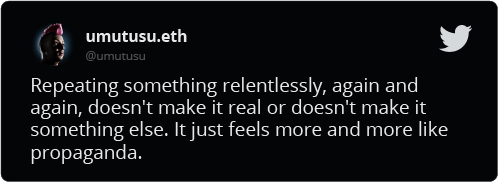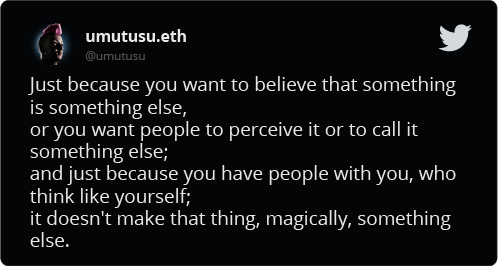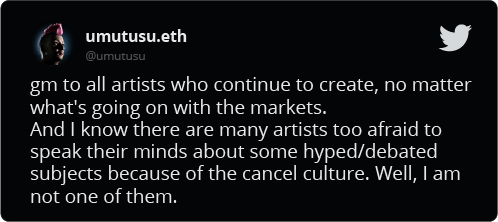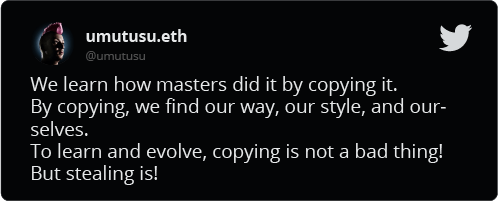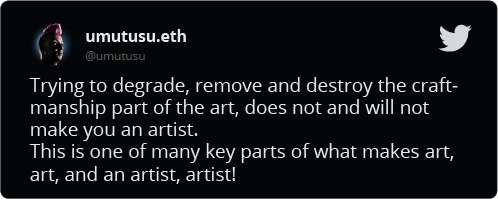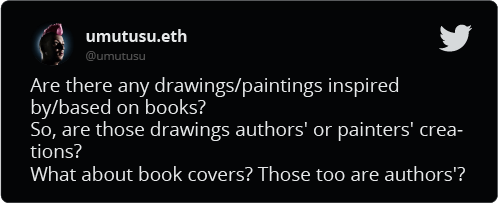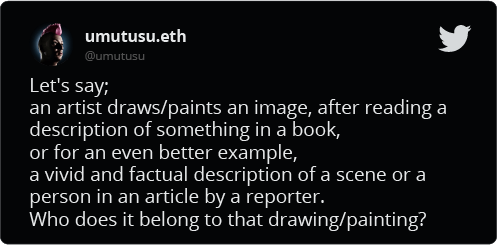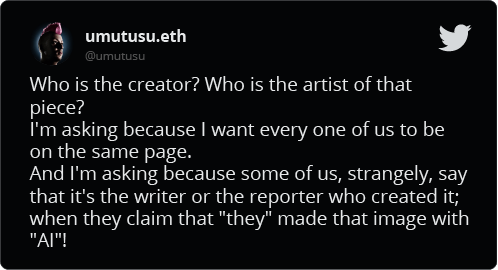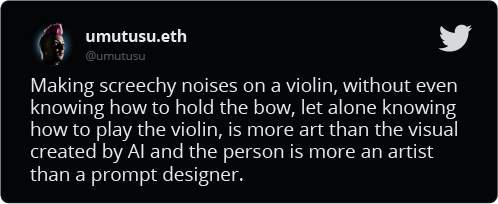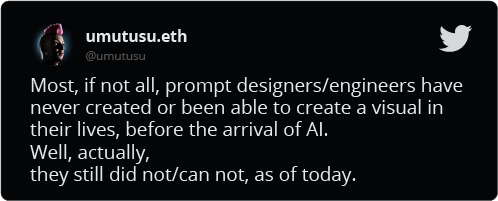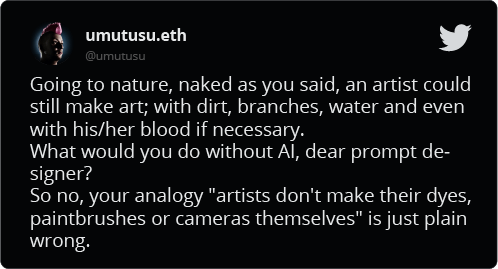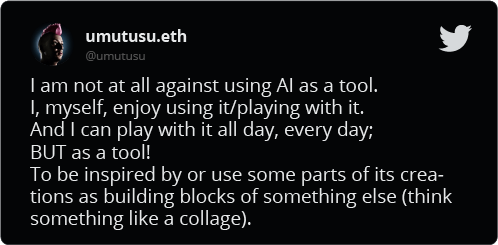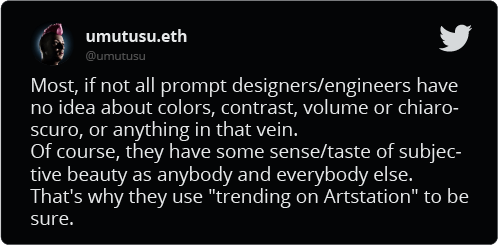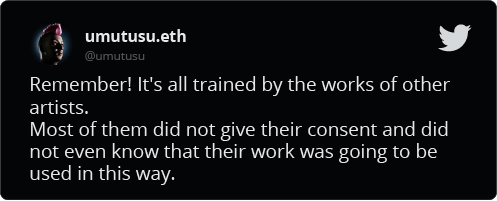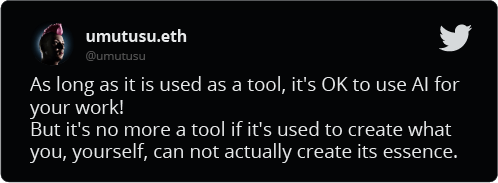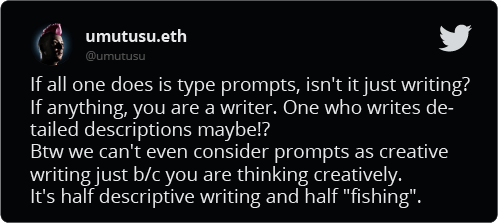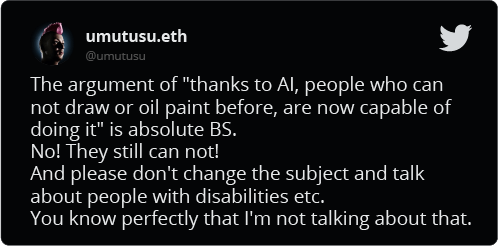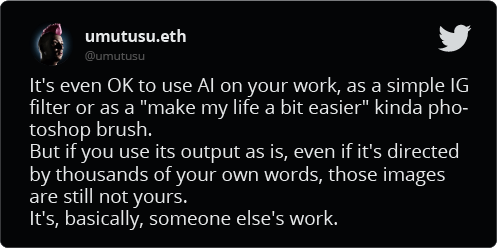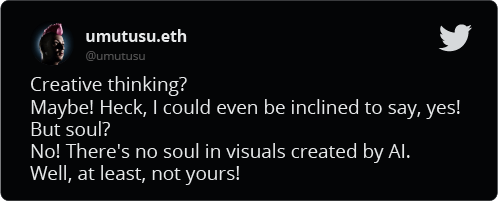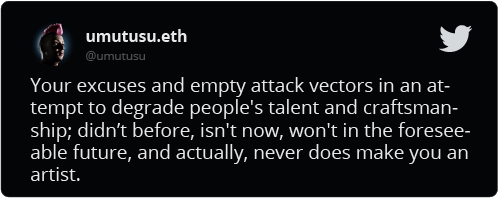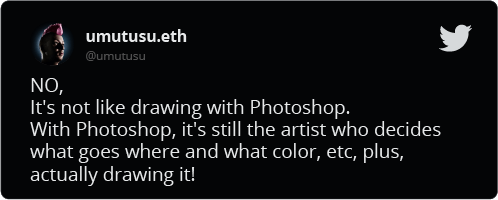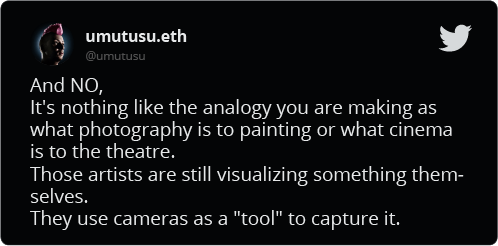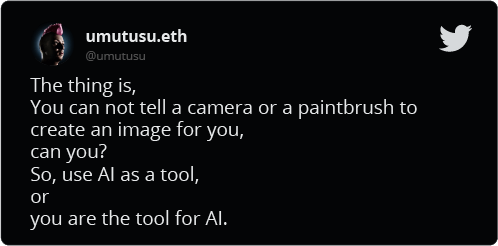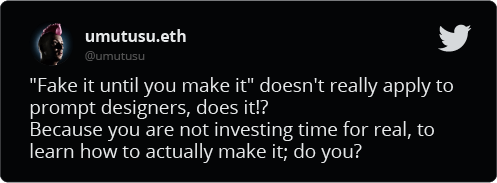- Q. I don't think prompt designers are artists if all they do is write prompts.
What do you think about images created by AI systems like Dall-E 2, Midjourney, or Stable Diffusion?
Can we consider visuals created by AI systems like Dall-E 2, Midjourney, or Stable Diffusion as art just because there is a human (prompt designer) who feeds text into it, and so, can we consider prompt designers as artists?
If not, why can’t we?
A.There is no universally accepted definition of art. However, there are some general characteristics that are often cited as being important for something to be considered art. Some of these characteristics include:
-Expression of an idea or feeling
-Intentional creation
-Communication of an idea
Another important factor is the role of the artist. In traditional art, the artist is considered to be the creator of the work. The role of the artist is to communicate their ideas through their work.
In the case of AI generated art, the AI system is the creator of the work. The role of the artist is to provide the AI system with input (e.g. text) that the AI system then uses to generate the artwork. Because the AI system is the creator of the work, it is difficult to argue that the artwork is an expression of the artist's ideas or feelings. Additionally, because the AI system is the creator of the work, it is also difficult to argue that the artwork is intentional. It is also unclear how well AI-generated art can communicate an idea, as the meaning of the artwork is often opaque.
A. There are a number of reasons why people using AI systems like Dalle-2 or Midjourney to create visuals cannot be considered as artists. Firstly, the AI systems are doing most of the work in creating the visuals, with the people using them simply providing the input. Secondly, the visuals produced by AI systems are often repetitive and lack the creativity and originality that is associated with art. Finally, the people using AI systems to create visuals are often not trained in art, and so would not be able to create artworks of the same quality as a trained artist.
A. The reason we can't consider people using AI systems like Dalle-2 or Midjourney to create visuals, as artists, is because they are not in control of the process. The machine is in control of the process and is making all the decisions.
A. As a painting inspired by a book is not the book's author's art, a visual created by AI with the words of the prompt designer is not the prompt designer's art: it is the art of the AI system.
As a result, the AI's art should be credited to the AI, not the prompt designer.
A. I don't think that the people who use AI systems to create images can be considered artists. The reason is that the AI system is doing the majority of the work in creating the image, not the person.
A. Therefore, the visual created by the AI is not art of the prompt designer, but it could be considered the art of the AI. Since we can't consider the AI as the artist, the visual it creates can't be art. So what is it?
It is difficult to say what the visual created by the AI is, as it is not clear what category it would fall into. It is not art, as it has not been created with the intention of being art. It is also not simply a data visualization, as it has not been created solely for the purpose of conveying information. It is a visual created by AI, which is a new and relatively unexplored category.
In conclusion, it is difficult to say what the visual created by AI is. It is not art, but it could be considered the art of the AI.
A. There are a few reasons why visuals created by AI systems like Dalle or Midjourney cannot be considered art. First, art is typically created by humans, not machines. Second, art is often created with the intention of conveying a message or emotion, whereas visuals created by AI systems are often created without any specific purpose or meaning. Finally, art is often judged based on its aesthetic value, and it is unclear if visuals created by AI systems would be able to meet this criteria.
Some people might argue that visuals created by AI systems can be considered art if they are created with the intention of conveying a message or emotion. However, it is difficult to create visuals that convey a message or emotion when the system is not designed for this purpose.
Overall, visuals created by AI systems cannot be considered art because they lack the key characteristics that define art.
A. There are a few reasons why we might not consider visuals created by AI systems like Dalle or Midjourney as art. Firstly, these systems often rely on pre-existing images or data in order to generate new visuals, meaning that they are not really creating anything new. Secondly, the visuals produced by these systems can often be quite abstract and unclear, making it difficult to appreciate them as art. Finally, art is often seen as something that requires a human touch, and as AI systems are not yet capable of replicating this, it is unlikely that we will consider their visuals as art anytime soon.
A. There are several reasons why we might not consider visuals created by AI systems like Dalle-2 or Midjourney as art. One reason is that, although a human prompt designer may feed text into these systems, the systems themselves generate the visuals that are outputted. This means that the creations of these systems are not necessarily reflective of the prompt designer's own artistic vision or intentions. Another reason why we might not consider these visuals as art is that they often lack the complex and nuanced understanding of the world that is often seen as necessary for art. Finally, these visuals often lack the originality and creativity that are often seen as key features of art.
A. There are a few reasons why visuals created by AI systems may not be considered art. First, AI-created visuals may be perceived as lacking in creativity or originality, as they are often based on pre-existing images or text. Second, AI-created visuals may be seen as too repetitive or formulaic, as they often use the same or similar images and text to create new visuals. Finally, AI-created visuals may be seen as too commercialized or mass-produced, as they are often created for marketing or advertising purposes.
A. There are many reasons why DALL-E 2's visuals cannot be considered art. First, DALL-E 2 is not a human being, and therefore cannot create art from a subjective perspective. Second, DALL-E 2's visuals are often chaotic and lack the coherence and structure that are characteristic of art. Finally, DALL-E 2's visuals are often created for commercial or utilitarian purposes, rather than for aesthetic or expressive ones.
- Q. Does just writing prompts to an AI like dalt-e 2 and the AI creating images, makes that person an artist?
A. No, it does not make that person an artist.
A. I don't think that the people who use AI systems to create images can be considered artists. The reason is that the AI system is doing the majority of the work in creating the image, not the person.
A. I don't think that the people who write prompts to AI systems like Dall-e 2 can be considered artists. The reason why is because the AI is the one creating the images, not the person who wrote the prompt. The person who wrote the prompt is just providing the AI with the information it needs to create the image.
A. Yes, I think it's possible to consider the visuals created by AI systems like Dalle-2 or Midjourney as art. After all, art is about the expression of ideas and emotions, and these AI systems are capable of doing that.
However, I don't think that the people who use AI to create these visuals can necessarily be considered artists. To be an artist, I think you need to have a certain level of creative control over your work. And while the people who use AI might have some control over the input (the text prompts), they don't have any control over the output (the visuals). So I don't think they can be considered artists in the same sense as someone who paints or sculpts.


